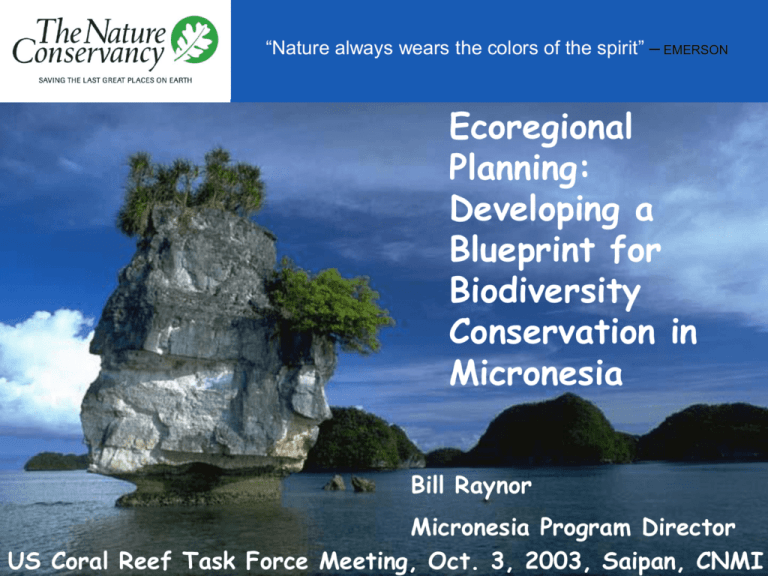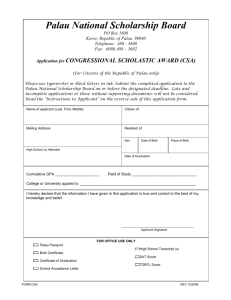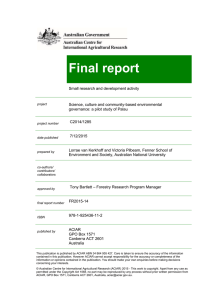
“Nature always wears the colors of the spirit” – EMERSON
Ecoregional
Planning:
Developing a
Blueprint for
Biodiversity
Conservation in
Micronesia
Bill Raynor
Micronesia Program Director
US Coral Reef Task Force Meeting, Oct. 3, 2003, Saipan, CNMI
Marjorie Reaka PPT
Kacky Andrews PPT
BEFORE WE BEGIN
What is the The Nature Conservancy
and who IS Bill Raynor? (web)
internships
etc.
http://www.savethehighseas.org/trawling.cfm
MAP OF ASIA PACIFIC
CSP Newsletter
Sakau drink pics from folder and plant
My pubs
PACIFIC ISLANDS REPORT
Pacific Islands Development Program/East-West Center
With Support From Center for Pacific Islands Studies/University of Hawai‘i
PALAU PRESIDENT URGES CONSERVATION
By Agnes M. Abrau
KOROR, Palau (Palau Horizon, Nov. 9) – Palau President Tommy Remengesau has
asked visiting U.S. officials to continue the "battle" against global warming and
threats to the world’s biodiversity.
In a speech to the participants of the U.S. Coral Reef Task Force meeting here on
Saturday, Remengesau said coral reef conservation is a national, regional and
international issue.
He said a global crisis requires global solutions and depends on global partnerships
at every level.
This, he added, "is truly our only hope to preserve our coral reefs for our children."
According to Remengesau, Palau is already a world leader in "ratio of area protected
to maintain biological diversity to surface area"
"For Palau, the environment is our economic future. We have no higher issue on our
agenda than the preservation of our natural resources. Because of this, we recognize
that a delicate balance must be struck between growth and conservation. We also
recognize our limitations. It is because of this recognition that we understand that
only through real partnerships and sharing will we achieve our mutual conservation
goals," Remengesau said.
He added that Palau involves itself in world conservation issues.
Palau is one of the first nations of the world to pass a law that prohibits shark finning
within its exclusive economic zone, he said.
The law prohibits commercial fishing within 50 miles of the country’s shores.
Remengesau said Palau also passed a protected area network law "that will stand as
the basic framework to allow to meet Palau’s commitment to protect and manage 30
percent of its total reef, mangrove and lagoon area, as well as 20 percent of its
forests, by 2010."
Moreover, he said, Palau sponsored, both in the United Nations and in the Pacific
Islands Forum, an initiative calling for the cessation of high seas bottom trawling.
Remengesau said that they had discussions with U.S. resource partners regarding
the proposed phase II of Palau’s resource management and zoning plan.
November 9, 2005
Marianas Variety: www.mvariety.com
Copyright © 2005 Marianas Variety. All Rights Reserved
Conservation by Design
ECOREGIONAL
PLANNING
MEASURES OF
SUCCESS
CONSERVATION
AREA PLANNING
(Single- & multi-area)
STRATEGIES
& ACTIONS
Steps of Ecoregional Planning
1. Determine the region of interest. ECOREGION
2. Define the representative ecosystems, natural communities, and selected
species that should be conserved. CONSERVATION TARGETS
3. Delineate the healthiest examples of these ecosystems, communities, and
species. VIABLE OCCURRENCES
4. Decide on how many examples of these ecosystems, communities, and species
need to be conserved. GOALS
5. Determine the areas that capture the most and best examples AREAS OF
BIOLOGICAL SIGNIFICANCE
6. Determine which of these areas are of highest priority to conserve. ACTION
AREAS
7. Develop actions that will help to conserve many areas of biological significance.
MULTI-AREA STRATEGIES
Why Ecoregional Planning?
•Planning starts at regional scales
rather than at specific sites, as this
allows for conservation of a full
range of biodiversity
•Many key threats operate at multisite scale
•Coordinated efforts can facilitate
partnerships and increase strategic
use of conservation resources
(strategic vs. opportunistic, proactive
vs. reactive)
Tuna, etc. move around this region’s waters
Step 1 - SELECT ECOREGION
What is underwater elevation called?
Why is it relevant to map for BIO-D?
Pen to delineate
Federated States of Micronesia
•An island nation in the
western Pacific
•An archipelago of 607
islands
•271 sq. miles of
land/2,700 sq. miles of
lagoons and coral reefs spread across 1,000,000
sq. miles of ocean
Background and where the $’s from
• FSM National Government received UNDP-GEF
assistance to do their National Biodiversity Strategy
and Action Plan (NBSAP)
• TNC was undergoing a national/regional expansion,
and needed to do Ecoregional Planning
• FSM NBSAP Task Force adopted the ecoregional
planning effort
• State BSAP teams assisted with ecoregional planning
process as experts and advisors
Step 2 - CONSERVATION TARGETS
Marine Ecosystems
Freshwater & Wetland Ecosystems
High island nearshore marine
(coral reefs, lagoons, sea grass, etc.)
Atoll nearshore marine
Atoll/Beach forest
Atoll inland mangrove
High island mangrove
Freshwater stream
Terminalia swamp forest
Riparian forest
Montane perched Freshwater swamp
Coastal freshwater marsh
Terrestrial Ecosystems
Selected Species
Chuuk flying fox
Pohnpei short-earred owl
Giant Micronesian gecko
Manta ray
Turtle nesting beaches
Giant clams
Upland broadleaf forest
Lowland broadleaf forest
Montane cloud forest
Fern/Sedge Savanna
Limestone forest
Ivory nut palm forest
Clinostigma palm forest
Step 3 -VIABLE OCCURRENCES
• How big?
• Water quality?
• Intact watershed?
• Resilience?
• Connectivity?
High Island Nearshore Marine
Upland Broadleaf Forest
• How big?
• How fragmented?
• What % agriculture?
• How many invasives?
FSM Data Gaps
•Inshore marine systems/
communities - lack of updated maps
and health/viability data
•Outer islands - lack presence and
health/viability data
•Open ocean - over all lack of data
•Submerged reefs - little data on
biodiversity and health/viability
•Marine Species - lack updated
surveys
Step 4 - GOALS
How much is enough?
Step 5 - AREAS OF BIOLOGICAL
SIGNIFICANCE
•Pick places that are the most
HEALTHY
•Pick places that capture the MOST
number of ecosystems, communities
& species
•Pick places RESISTANT to large
scale threats such as bleaching
•Pick sites that have
CONNECTIVITY
•Pick places that are the most
FEASIBLE to work in.
Step 6 - ACTION AREAS
Biological Value
Number/diversity of
targets
Health or integrity
Urgency of threat
Feasibility
Leverage
Step 7 - Multi-Area Strategies
Strategies must respond to key
marine threats:
•Overfishing- 50% of ABS sites
•Coastal Erosion/Sea Level Rise
•Water pollution - 16%
•Destructive harvesting - 15%
•Basin erosion and sedimentation
Partnerships
• FSM National Government (NBSAP Task Force, Dept. of
Economic Affairs, NORMA)
• Kosrae, Pohnpei, Yap, and Chuuk States
• NGOs - CSP, KCSO, GATA,YESC
• College Of Micronesia - FSM
• UNDP-GEF
• Regional Universities (UoG, UH)
• US Federal Programs (DOI, USFS, USDA-NRCS,
NOAA)
• The Nature Conservancy
Benefits of Linking ERP to NBSAP
• Government and community ownership of
ecoregional plan (shared “map of success”)
• Focus all stakeholders on priority sites, species,
and long-term biological viability
• Build partnerships to deal with multi-site
threats
• Increased strategic use of limited conservation
resources
• High visibility to potential donors
RESULTS SO FAR
• Major funding from outside sources to keep
work moving
• Local leaders staking over process and training
younger members of society to do the work
• Multiple areas protected
• Measurements and analysis of efforts ongoing
• Palau seeking UN status and this will allow it
to push such issues and combat certain fishing
techniques
END SLIDE SHOW
Other Linkages
Micronesia Conservation Trust - “location in an
ABS site” as grant criteria
Micronesia Leaders in Island Conservation focus on leaders and organizations working at
ABS sites
Compact Environment Sector - provide funding
for recurrent activities (e.g., protected areas
management/enforcement) focussed in ABS
sites











